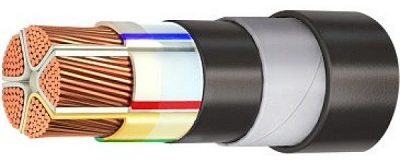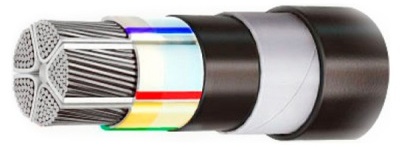What is an armored cable
Armored cable contains one or more conducting conductors consisting of tinned copper or soft conductors that are insulated with polyethylene, propylene copolymer or fluoropolymer composition, depending on the maximum permissible operating temperature of this cable. As the name suggests, the cable is shielded — wrapped in several layers of galvanized steel wire.
Such a cable has high strength, can withstand significant mechanical stress and is resistant to corrosion and moisture. It will last up to 50 years without problems, it can be stored in almost any conditions and at ambient temperatures from -50 ° C to + 50 ° C, while the maximum permissible temperature of conductive wires can reach + 90 ° C, while the cable will remain in service ... So all material costs for repair and maintenance of the armored cable are minimized.

The most common types of armored cables are VBbShv cables (with copper conductors) and AVBbShv (with aluminum conductors). They are produced with a cross-section of wires from 1.5 to 240 square mm. When the cross-section of the wires is more than 25 sq.Mm, wires can have a sector cross-section (similar to a piece of a circle).
Usually there are from 1 to 5 such wires in the cable, and if there are 4 wires, then the neutral wire may have a smaller cross-section than the other 3. Each wire of the cable has its own color marking, indicating the neutral and phase wires. Modifications of cables for voltages — from 660 V to 35 kV.

The abbreviation of the name means:
-
B — wires have PVC insulation;
-
B — sheet armor formed by a double galvanized spiral with overlapping gaps;
-
b — the cable has a bitumen layer (for cables with a conductor cross-section of more than 6 square mm);
-
Shv — The cable is wrapped in a PVC hose;
-
A — aluminum conducting wires;
Although cables with copper conductors (VbbShv) are more expensive, they are superior in performance to cables with aluminum conductors (AVBbShv). But since the aluminum version is cheaper, it is the aluminum version of the armored cable that is most widely used.
Armored cable with copper conductors has a much more protected insulation that can withstand the most aggressive external environment, which is why it is used for laying cable routes with high strength requirements. In the absence of tension loading, this type of cable can also be laid outdoors.
As mentioned above, several layers of steel tape wrapped in a PVC hose reliably protect the core of such a cable. He is not afraid of man-made mechanical influences, even less of rodents.
Armored cable with aluminum conductors has no shield. Conductors with a significant cross-section are made of several wires. PVC compound is used as insulation. As armor — a spiral made of galvanized tape.Like copper cable, aluminum cable does not allow for much stretching. The insulation of the AVBbShng cable does not support burning, therefore, when laying the cable in bundles, it is fire-resistant.
Armored cables of different types and purposes are presented on the market today: power cables, communication cables and optical cables. The shield of the cable ensures its reliable operation in all weathers. The copper cable is suitable for underground, surface and indoor installation.
Most often, this is a copper power cable, which is laid in an open way in trenches, laid in mines and collectors — wherever high corrosive activity of the environment is possible. Aluminum cable is laid in trenches, mines, tunnels, as well as indoors and outdoors.
